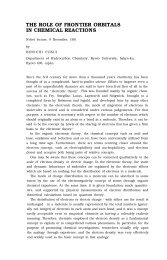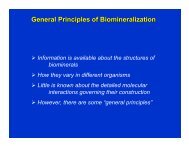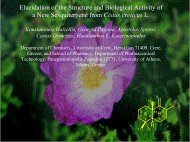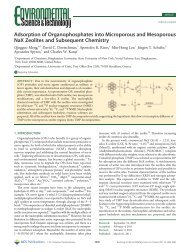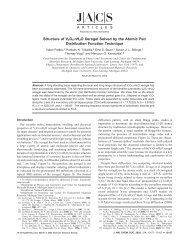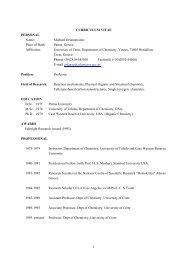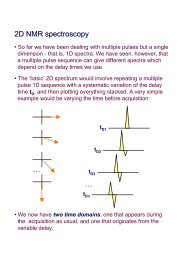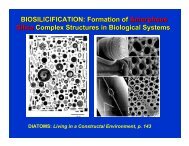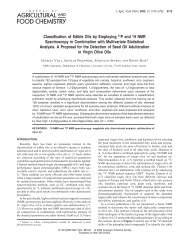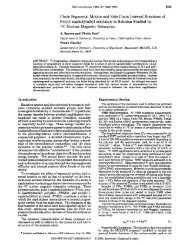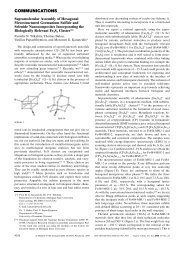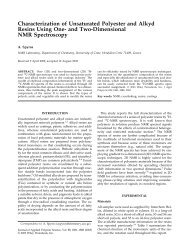Detection of Extra Virgin Olive Oil Adulteration with - Department of ...
Detection of Extra Virgin Olive Oil Adulteration with - Department of ...
Detection of Extra Virgin Olive Oil Adulteration with - Department of ...
You also want an ePaper? Increase the reach of your titles
YUMPU automatically turns print PDFs into web optimized ePapers that Google loves.
<strong>Detection</strong> <strong>of</strong> <strong>Extra</strong> <strong>Virgin</strong> <strong>Olive</strong> <strong>Oil</strong> <strong>Adulteration</strong> J. Agric. Food Chem., Vol. 53, No. 8, 2005 2811<br />
an assessment <strong>of</strong> the olive oil quality according to EU<br />
regulations (ECN 42, spectroscopic constants K 232-270 , triglycerides,<br />
peroxide value, etc.).<br />
In the past decade, there has been an increasing interest in<br />
the classification <strong>of</strong> edible oils including olive oil as an<br />
alternative means to examine authentication and to detect<br />
possible adulteration <strong>of</strong> extra virgin olive oils <strong>with</strong> seed oils<br />
and/or olive oils <strong>of</strong> lower grade. Classification <strong>of</strong> various grades<br />
<strong>of</strong> olive oil has been carried out in several instances by using<br />
a variety <strong>of</strong> analytical techniques and chemometric procedures.<br />
Among these are classical methods based on gas chromatography<br />
and high-performance liquid chromatography (7, 8), mass<br />
spectrometry (9), isotope mass ratio analysis (10), metal oxide<br />
sensors (6), vibrational spectroscopy (11-16), and nuclear<br />
magnetic resonance (NMR) spectroscopy (17-20).<br />
In a recent publication (21) we proposed a methodology based<br />
on NMR spectroscopy in combination <strong>with</strong> multivariate statistical<br />
analysis to classify 13 types <strong>of</strong> edible oils and to detect virgin<br />
olive oil adulteration <strong>with</strong> corn, soybean, sunflower, and<br />
hazelnut oils. In particular, 31 P NMR spectroscopy was used to<br />
determine in a single experiment 1,2-diacylglycerols (1,2-DGs),<br />
1,3-diacylglycerols (1,3-DGs), total diacylglycerols (TDGs), the<br />
ratio D <strong>of</strong> 1,2-DGs over TDGs, total free sterols, and free acidity.<br />
This method (21) is based on the derivatization <strong>of</strong> the labile<br />
hydrogens <strong>of</strong> hydroxyl and carboxyl groups <strong>with</strong> 2-chloro-<br />
4,4,5,5-tetramethyl dioxaphospholane (1) and the use <strong>of</strong> the 31 P<br />
chemical shifts <strong>of</strong> the phosphitylated compounds to identify the<br />
labile centers. The phosphorus reagent reacts rapidly and<br />
quantitatively under mild conditions <strong>with</strong> the hydroxyl and<br />
carboxyl groups (21). The same procedure will be used in the<br />
present study to discriminate among three different grades <strong>of</strong><br />
olive oil, namely, EVOO, ROO, and LOO, and to detect EVOO<br />
adulteration <strong>with</strong> these oils.<br />
MATERIALS AND METHODS<br />
Samples and Reagents. Thirty-four EVOO harvested between<br />
2001and 2003 were provided by local cooperatives. Twenty-one olive<br />
oils were sampled in Crete (Peza, Kolymbari, Heraklion, Sitia), 3 oils<br />
in Messinia, and 1 in Ilia. They were extracted from the olive variety<br />
Koroneiki, whereas the oils from Lakonia (6 oils), Lesvos (1 oil), and<br />
Pilion (2 oils) were extracted from the varieties Athinolia, Kolovi, and<br />
a local variety, respectively. The samples were extracted by centrifugation<br />
<strong>with</strong>in 48 h after harvesting and stored immediately in brown<br />
screw-capped bottles at -20 °C prior to spectrum acquisition and were<br />
coded as extra virgin olive oils according to the <strong>of</strong>ficial limits (4). A<br />
total <strong>of</strong> 25 samples <strong>of</strong> olive oil <strong>of</strong> lower quality were kindly supplied<br />
by the olive oil company Minerva (Athens, Greece): 12 samples <strong>of</strong><br />
LOO and 13 samples <strong>of</strong> ROO. Refined olive oils were deodorized in<br />
the final step <strong>of</strong> the refining process. Finally, six commercial samples<br />
<strong>of</strong> blended olive oil composed <strong>of</strong> refined olive oil and virgin olive oil<br />
(BOO) were purchased from local supermarkets.<br />
The 31 P NMR method was applied to detect olive oil adulteration.<br />
Fresh EVOO samples were mixed <strong>with</strong> LOO and ROO samples. Two<br />
set <strong>of</strong> mixtures <strong>of</strong> 1, 3, 5, 10, 15, 20, 35, 50, 65, and 80% (w/w) and<br />
1, 3, 5, 10, 15, 20, 35, and 50% for ROO adulterant in EVOO and one<br />
set <strong>of</strong> 1, 3, 5, 10, 15, and 20% (w/w) <strong>of</strong> LOO in EVOO were prepared.<br />
EVOO samples <strong>of</strong> different geographical and botanical origins and<br />
different ROO samples were used for the preparation <strong>of</strong> the various<br />
mixtures. Finally, three EVOO samples <strong>of</strong> different geographical and<br />
botanical origins (1 from Pilion, 1 from Sitia, and 1 from Lesvos), not<br />
included in the 34 EVOO samples used for the present analysis, were<br />
adulterated <strong>with</strong> different ROO samples at concentrations <strong>of</strong> 60, 65,<br />
70, 75, and 80% (w/w). These mixtures were analyzed by 31 P NMR<br />
spectroscopy and used as blank tests to estimate the composition <strong>of</strong><br />
BOO samples. All olive oil samples and their mixtures were analyzed<br />
twice.<br />
Pinacol, triethylamine, phosphorus trichloride, protonated solvents<br />
(reagent or analytical grade), and deuterated solvents used in the present<br />
study were purchased from Sigma-Aldrich (Athens, Greece). The<br />
derivatizing phosphorus reagent 2-chloro-4,4,5,5-tetramethyldioxaphospholane<br />
(1) was synthesized from pinacol and phosphorus trichloride<br />
following the method described in the literature (23). However, to<br />
increase the yield <strong>of</strong> the reaction, we utilized hexane solvent instead<br />
<strong>of</strong> benzene and pyridine instead <strong>of</strong> triethylamine as suggested in the<br />
original method. This modification resulted in ∼45% yield <strong>of</strong> the<br />
product against 19% obtained <strong>with</strong> the original method.<br />
Sample Preparation for 31 P NMR Spectral Analysis. A stock<br />
solution was prepared by dissolving 0.6 mg <strong>of</strong> chromium acetylacetonate,<br />
Cr(acac) 3 (0.165 µM), and 13.5 mg <strong>of</strong> cyclohexanol (13.47 mM)<br />
in 10 mL <strong>of</strong> a mixture <strong>of</strong> pyridine and CDCl 3 solvents (1.6:1.0 volume<br />
ratio) and protected from moisture <strong>with</strong> 5A molecular sieves. Cyclohexanol<br />
was used as an internal standard for quantification purposes.<br />
<strong>Olive</strong> oil (100-150 mg) was placed ina5mmNMRtube. The required<br />
volumes <strong>of</strong> the stock solution (0.4 mL) and the reagent 1 (15 µL) were<br />
added. The reaction mixture was left to react for ∼15 min at room<br />
temperature. Upon completion <strong>of</strong> the reaction, the solution was used<br />
to obtain the 31 P NMR spectra.<br />
13<br />
P NMR Experiments. 13 P NMR experiments were conducted on<br />
a Bruker AMX500 spectrometer operating at 202.2 MHz for the<br />
phosphorus-31 nucleus at 30 ( 1 °C. The spectra were recorded by<br />
employing the inverse gated decoupling technique in order to suppress<br />
NOE. Typical spectral parameters for quantitative studies were as<br />
follows: 90° pulse width ) 12.5 µs, sweep width ) 10 kHz, relaxation<br />
delay ) 30 s, memory size ) 16K (zero-filled to 32K). Line broadening<br />
<strong>of</strong> 1 Hz was applied, and drift correction was performed prior to Fourier<br />
transform. Polynomial fourth-order baseline correction was performed<br />
before integration. For each spectrum 32 transients were accumulated.<br />
All 31 P chemical shifts are relative to the product <strong>of</strong> the reaction <strong>of</strong> 1<br />
<strong>with</strong> water (moisture contained in all samples), which gives a sharp<br />
signal in pyridine/CDCl 3 at δ 132.20. It should be noted that the<br />
presence <strong>of</strong> the paramagnetic metal center <strong>of</strong> Cr(acac) 3 in the samples<br />
lowers the relaxation times <strong>of</strong> the phosphorus nuclei, shortening thus<br />
the duration <strong>of</strong> the measurements significantly. The relaxation delay<br />
in the 90° pulse sequence is based on the 31 P spin-lattice relaxation<br />
time <strong>of</strong> 4.9 s measured for the internal standard. Lower values were<br />
measured for other model compounds (3.5 s for stearic acid and 2.3 s<br />
for 1,2-diolein). Therefore, the relaxation delay (5 times the longest<br />
relaxation time) is suitable for quantitative analysis. The applicability<br />
<strong>of</strong> this method to quantitative analysis, as well as its reproducibility<br />
and repeatability, has been tested thoroughly in previous studies (20,<br />
21).<br />
Statistical Analysis. One-way ANOVA was used to find the<br />
variables <strong>with</strong> the highest discriminatory power. The results <strong>of</strong> this<br />
analysis are reported as the Fisher F ratios and p level. The F ratio<br />
<strong>with</strong> the degrees <strong>of</strong> freedom tests whether the between and <strong>with</strong>in<br />
variances are significantly different. The p level represents a decreasing<br />
index <strong>of</strong> reliability <strong>of</strong> a result and gives the probability <strong>of</strong> error involved<br />
in accepting a result as valid. The results reported below show that the<br />
selected variables were significantly different for the three grades <strong>of</strong><br />
olive oil. The unsupervised statistical method <strong>of</strong> hierarchical cluster<br />
analysis (HCA) was applied to explore similarity (or dissimilarity)<br />
among the various olive oil samples, whereas the supervised method<br />
discriminant analysis (DA) classified olive oils according to different<br />
grades and detected adulteration. Discriminant function analysis is used<br />
to determine which variables (e.g., compositional parameters <strong>of</strong> olive<br />
oil samples) discriminate between two or more naturally occurring<br />
groups (e.g., olive oil grades). The DA method applied to a matrix <strong>of</strong><br />
5 independent variables and 59 olive oil samples provided good results<br />
(see below) while being very straightforward in calculation and<br />
interpretation. Visualization <strong>of</strong> the oil classification is achieved by<br />
plotting the individual scores for two principal discriminant functions,<br />
whereas for the detection <strong>of</strong> EVOO adulteration the discriminant<br />
functions obtained from the DA model and the Mahalanobis distances<br />
were used. The statistical package Statistica for Windows 5.1B (StatS<strong>of</strong>t<br />
Inc.) was used.<br />
RESULTS AND DISCUSSION<br />
Data Analysis. Results are summarized in Tables 1-3. Table<br />
1 contains the percentage content <strong>of</strong> five chemical components




